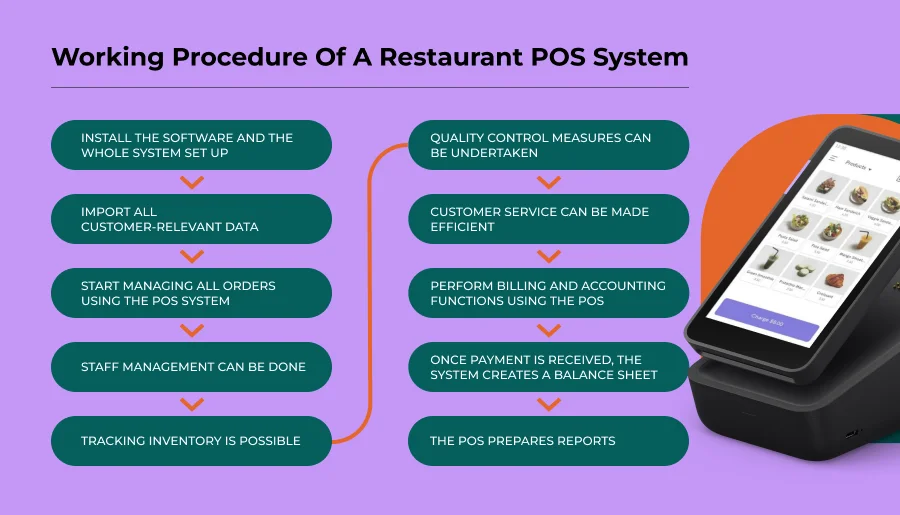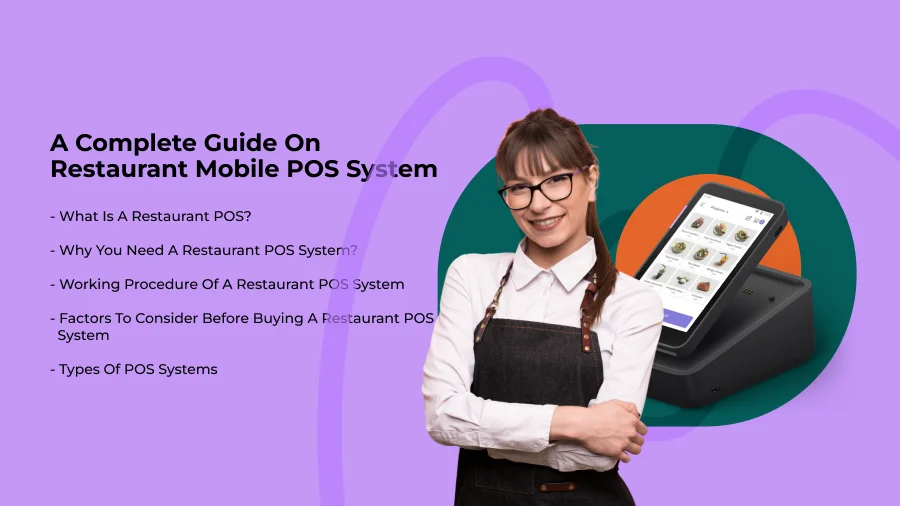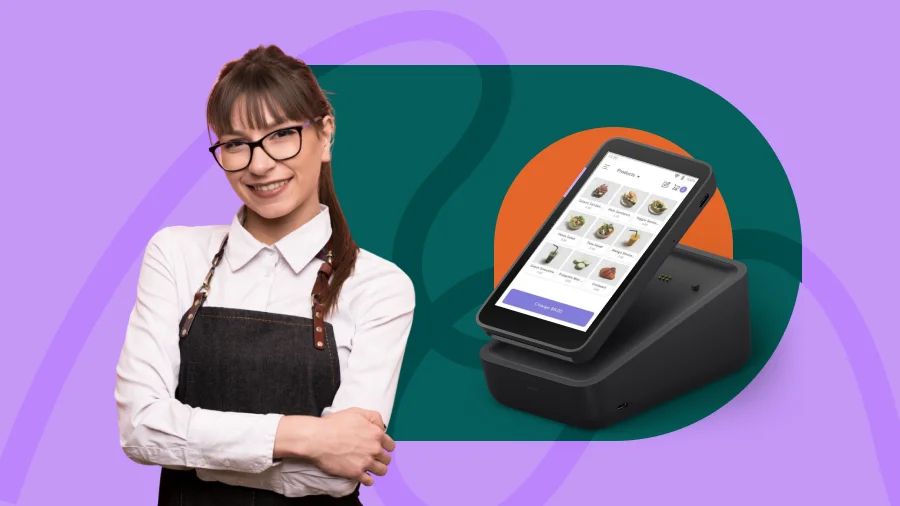A complete guide on restaurant mobile POS system
Restaurant owners tend to believe that innovation in their industry can be achieved when new signature dishes or daily specials are added to their menu. But the reality is that the biggest innovations have less to do with the menu and more with the technology that is governing everyday restaurant operations and increasing efficiency.
With a mobile POS system, a restaurant can become next-gen and witness profound growth, a positive impact on business operations, guest satisfaction, revenue growth, brand building and overall prosperity.
If you do not wish to be left behind, use a customizable, flexible and modern POS technology that has quickly become the hallmark of cloud-based business management.

Restaurant POS systems have paved the way for several features and functionalities that have seamlessly streamlined the operations of both the front house and back house. The abundance of new technology has revolutionized the way restaurants function these days.
This blog will tell you what a restaurant POS system is and the factors that must be considered to choose the right one for the business.
A restaurant Point-Of-Sale (POS) is a computer system that is used to manage and streamline a restaurant’s operations. POS refers to the time and place a sales transaction is completed.
POS systems available in the market today execute much more than accepting payments from customers. A mobile POS system can be used by restaurant staff to send orders to the Kitchen Display System (KDS) so that chefs can prepare food accordingly and efficiently. A modern POS system records sales data, thus helping managers to track inventory and place orders only when needed.

Why You Need A Restaurant POS System?
- Streamlines operations by automating and taking care of daunting tasks like taking orders, inventory tracking and reporting.
- Makes sure that everything is accurate and error-free
- Helps achieve customer satisfaction by speeding up the ordering process and offering flexible payment options
- Provides real-time data on sales, inventory levels and customer preferences
- Managing staff schedules and tracking performance easy
Working Procedure Of A Restaurant POS System

The restaurant POS system plays a pivotal role in a restaurant’s management system. So, a restaurant owner must have proper knowledge about the way a restaurant POS system works.
- The software must be installed and the whole system set up
- Once the installation and setup is done, all customer-relevant data must be imported
- Now you can manage all orders using this POS system
- When orders are received, staff can be managed using this POS
- Tracking the inventory is possible using the POS
- Quality control measures can be undertaken through the POS
- Customer service can be made efficient
- The POS can be used to perform billing and accounting functions
- Once the payment is received, the system creates a balance sheet
- During the final step, it prepares reports
Factors To Consider Before Buying A Restaurant POS System
With several restaurant POS systems available in the market, choosing the best can be a daunting task. Take your time and remember to check if the POS has the following features before deciding.
Inventory Tracking
When the POS system has this feature, it helps save time and money by keeping constant track of stock levels and reducing the chances of over-ordering. Some systems also offer the feature of recipe costing that helps price the dishes appropriately.
Supply Chain Management
A good restaurant POS system ensures that supplies are always adequate. It keeps track of orders and monitors vendors ensuring that the restaurant owner gets the best possible prices.
Customer Data Management
When this feature is available in the POS system, you can easily keep track of the customer’s earlier orders, their preferences and contact details. This data can help improve customer service and improve brand loyalty. When data is streamlined, report generation and decision making gets quicker and more accurate.
Table Reservation
This feature is important for a restaurant POS system as it optimizes seating arrangements and ensures that guests feel comfortable. It helps keep track of reservations and nullifies the chances of overbooking. It keeps track of the customer’s reservations and their contact information. This will help follow up customers after the meal and get their feedback. By knowing how many people are seated at each table, you can optimize the waitstaff time and help things run smoothly. It streamlines operations and provides a better customer experience.
Insightful Reporting
When the POS has a robust reporting feature, once can track sales patterns, identify peak hours or slow days, manage staff timing and take proper inventory-based decisions. The system should be able to generate reports about sales, inventory and customer trend reports. With access to such crucial data, the restaurant gains a significant advantage over its competitors.
Order Management
A POS system must be capable of handling orders with lightning speed and utmost accuracy. Features like table mapping, order customization, check splitting and payment processing ensure a smooth and hassle-free ordering experience not just for the customers but for the staff too.
Integration With Other Systems
If the POS integrates with other systems like accounting or payroll software or online ordering platforms, operations can be streamlined. It decreases the need for manual data entry, ultimately saving time and money.
Customization
A restaurant POS system should reflect the unique nature of a restaurant. Ensure that you select a POS using which menu items can be added, prices and taxes modified, and custom reports generated. Only with customization can the POS be tailored to fit the specific needs of the restaurant.
User-Friendly Interface
When the POS has a simple and user-friendly interface, it reduces the learning curve of the staff and ensures that they make maximum use of the system for the benefit of the business. Choose a system that is intuitive and requires no special technical skills to use. Provide adequate training for the restaurant staff to ensure they operate the system the right way.
Customer Support
Select a POS that offers robust customer support. Seek a provider that comes along with phone or email support, adequate training resources and an online knowledge base. When customer support is reliable, issues or concerns can be addressed immediately, and business will run smoothly.
Types Of POS Systems
There are different types of POS systems designed to meet the specific needs of various industries and businesses. The three major types are:
Cloud-based POS Systems
They are web-based systems that store data and process transactions using the internet instead of a local server. So, the restaurant owner can access information at any time, any place and any gadget. Such systems are scalable and offer real-time data analytics. They are also pocket-friendly and can be purchased with a monthly subscription fee for support and maintenance. The drawback is that highly valuable sensitive data is stored in remote servers that are vulnerable to unauthorized access.
On-premises POS Systems
These are conventional systems installed and run on-site using a dedicated server in the restaurant. It takes care of all aspects of the restaurant operations from taking orders to inventory management and payment processing. Since they are installed on the business site and don’t need an internet connection to work, you are unlikely to face downtime or network issues. Since the restaurant owns the system and controls it, the configuration and customization can be done to meet the specific needs of the restaurant. The drawback is that they require a huge upfront investment for securing hardware and software licenses. One must also incur ongoing expenses for maintenance and support. Unlike cloud-based systems, they are not scalable too. Such a system might not be the right choice if you value scalability and flexibility.
Hybrid POS System
As the name suggests, it combines the best of both worlds – traditional and cloud-based POS systems. It is perfect for restaurants that wish to keep up with the times. This type of system has a conventional hardware setup that includes a cash register or terminal that is connected to a cloud-based platform. By opting for a hybrid POS system, you get to enjoy the speed and reliability of traditional systems along with the flexibility and accessibility of cloud-based systems. The beauty of this system lies in the fact that it can operate even with a sluggish or no internet connection. There is also greater flexibility in terms of hardware options. Their advanced reporting and analytics features give businesses more insights.

This blog would have helped you understand the importance of using the right POS system for your restaurant. All you must do is to consider your budget, analyze your unique needs, read testimonials from people who are using it, witness a live demo and ask for recommendations.
You are now armed with the knowledge and confidence to make an informed decision. Choose a POS system that is best for you and the restaurant. To make your business soar to new heights, get in touch.
